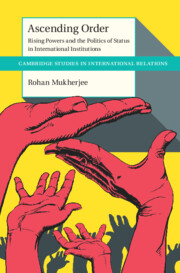Book contents
- Reviews
- Ascending Order
- Cambridge Studies in International Relations: 160
- Ascending Order
- Copyright page
- Dedication
- Epigraph
- Contents
- Figures
- Tables
- Acknowledgments
- Abbreviations
- 1 Introduction
- 2 Conceptual Foundations
- 3 Institutional Status Theory
- 4 The United States and the Atlantic System in the Nineteenth Century
- 5 Japan and the Washington System in the Interwar Period
- 6 India and the International Order of the Cold War
- 7 China and the Liberal International Order
- 8 Conclusion
- Appendix Case Selection
- Index
- Cambridge Studies in International Relations
6 - India and the International Order of the Cold War
Published online by Cambridge University Press: 21 July 2022
- Reviews
- Ascending Order
- Cambridge Studies in International Relations: 160
- Ascending Order
- Copyright page
- Dedication
- Epigraph
- Contents
- Figures
- Tables
- Acknowledgments
- Abbreviations
- 1 Introduction
- 2 Conceptual Foundations
- 3 Institutional Status Theory
- 4 The United States and the Atlantic System in the Nineteenth Century
- 5 Japan and the Washington System in the Interwar Period
- 6 India and the International Order of the Cold War
- 7 China and the Liberal International Order
- 8 Conclusion
- Appendix Case Selection
- Index
- Cambridge Studies in International Relations
Summary
This chapter traces India’s status concerns from independence in 1947 leading up to the advent of the NPT in the late 1960s. It examines India’s approach to nuclear weapons during this period and derives expectations for how India would react to an international treaty such as the NPT from two competing perspectives: material interests and IST. It tests these hypotheses through a detailed account, based on primary sources, of India’s approach to nuclear proliferation and positions taken in the International Atomic Energy Agency (IAEA) negotiations of 1954–1956 and in the Eighteen-Nation Committee on Disarmament from1962 to 1969. It finds that although India faced a major nuclear threat from China, India supported nonproliferation and universal nuclear disarmament, so long as the international nuclear negotiations allowed symbolic equality with the great powers and the door to joining the nuclear club remained open. When the superpowers drafted an NPT that effectively froze the number of recognized nuclear powers for the next 25 years, Indian perceptions of the openness and fairness of the international order changed, leading India to reject the NPT and undertake the very costly and risky step of testing a nuclear weapon.
Keywords
- Type
- Chapter
- Information
- Ascending OrderRising Powers and the Politics of Status in International Institutions, pp. 191 - 245Publisher: Cambridge University PressPrint publication year: 2022

